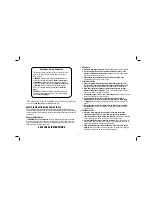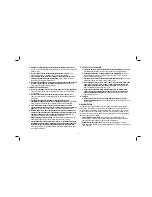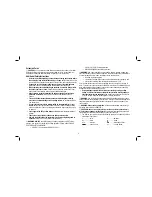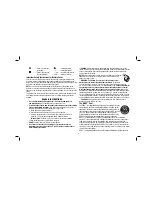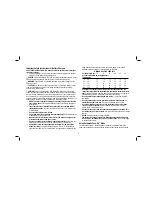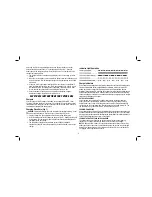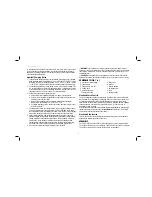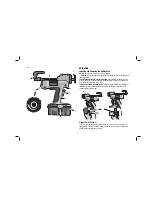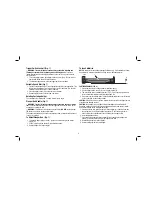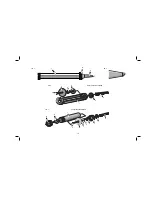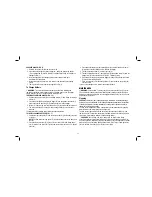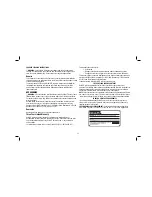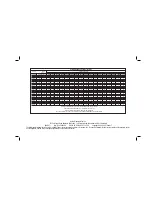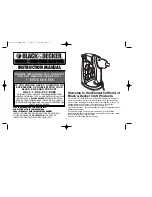
2
d. Remove any adjusting key or wrench before turning the power tool on.
A
wrench or a key left attached to a rotating part of the power tool may result in
personal injury.
e. Do not overreach. Keep proper footing and balance at all times.
This
enables better control of the power tool in unexpected situations.
f. Dress properly. Do not wear loose clothing or jewellery. Keep your hair,
clothing and gloves away from moving parts.
Loose clothes, jewellery or
long hair can be caught in moving parts.
g. If devices are provided for the connection of dust extraction and collection
facilities, ensure these are connected and properly used.
Use of these
devices can reduce dust related hazards.
4. POWER TOOL USE AND CARE
a. Do not force the power tool. Use the correct power tool for your application.
The correct power tool will do the job better and safer at the rate for which it
was designed.
b. Do not use the power tool if the switch does not turn it on and off.
Any
power tool that cannot be controlled with the switch is dangerous and must
be repaired.
c. Disconnect the plug from the power source before making any
adjustments, changing accessories, or storing power tools.
Such preventive
safety measures reduce the risk of starting the power tool accidentally.
d. Store idle power tools out of the reach of children and do not allow
persons unfamiliar with the power tool or these instructions to operate the
power tool.
Power tools are dangerous in the hands of untrained users.
e. Maintain power tools. Check for misalignment or binding of moving parts,
breakage of parts and any other condition that may affect the power tools
operation. If damaged, have the power tool repaired before use.
Many
accidents are caused by poorly maintained power tools.
f. Keep cutting tools sharp and clean.
Properly maintained cutting tools with
sharp cutting edges are less likely to bind and are easier to control.
g. Use the power tool, accessories and tool bits etc., in accordance with these
instructions and in the manner intended for the particular type of power tool,
taking into account the working conditions and the work to be performed.
Use of the power tool for operations different from those intended could result
in a hazardous situation.
5. BATTERY TOOL USE AND CARE
a. Ensure the switch is in the off position before inserting battery pack.
Inserting
the battery pack into power tools that have the switch on invites accidents.
b. Recharge only with the charger specified by the manufacturer.
A charger
that is suitable for one type of battery pack may create a risk of fire when
used with another battery pack.
c. Use power tools only with specifically designated battery packs.
Use of any
other battery packs may create a risk of injury and fire.
d. When battery pack is not in use, keep it away from other metal objects like
paper clips, coins, keys, nails, screws, or other small metal objects that
can make a connection from one terminal to another.
Shorting the battery
terminals together may cause burns or a fire.
e. Under abusive conditions, liquid may be ejected from the battery; avoid
contact. If contact accidentally occurs, flush with water. If liquid contacts
eyes, additionally seek medical help.
Liquid ejected from the battery may
cause irritation or burns.
6. SERVICE
a. Have your power tool serviced by a qualified repair person using only
identical replacement parts.
This will ensure that the safety of the power tool
is maintained.
Electrical Safety
The electric motor has been designed for one voltage only. Always check that the
power supply corresponds to the voltage on the rating plate. 230 V AC means your
tool will operate on alternating current. As little as 10% lower voltage can cause loss
of power and can result in overheating. All D
E
WALT tools are factory tested; if this
tool does not operate, check the power supply. Your D
E
WALT tool is double insulated,
therefore no earth wire is required.
•
Young children and the infirm.
This appliance is not intended for use by
young children or infirm persons without supervision. Young children should be
supervised to ensure that they do not play with this appliance.
•
Replacement of the supply cord.
If the supply cord is damaged, it must be
replaced by the manufacturer or an authorised D
E
WALT Service Centre in order to
avoid a hazard.
Summary of Contents for DC545-XE
Page 1: ...DC545 XE DC546 XE DC547 XE HEAVY DUTY 18V CORDLESS ADHESIVE GUN INSTRUCTION MANUAL ...
Page 2: ......
Page 15: ...13 ...



